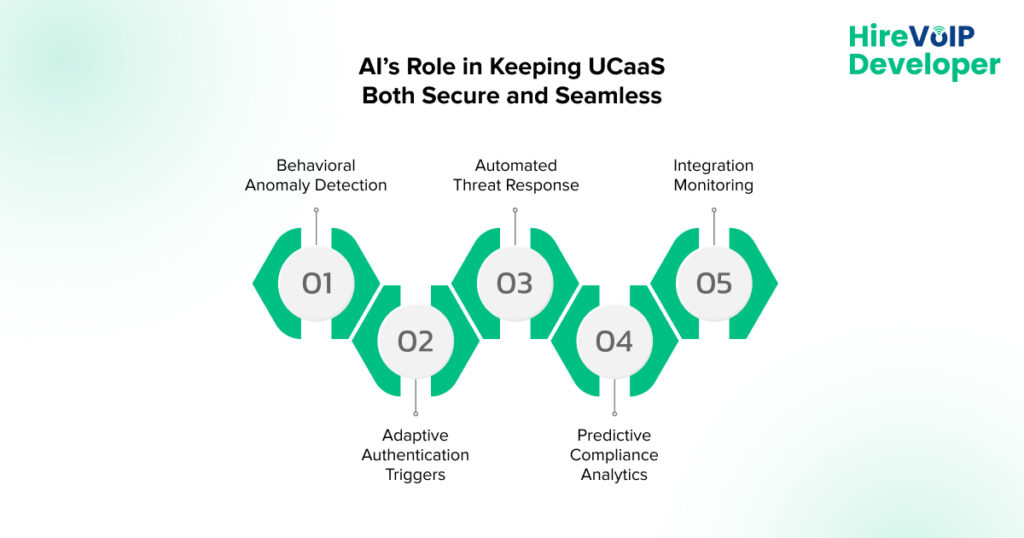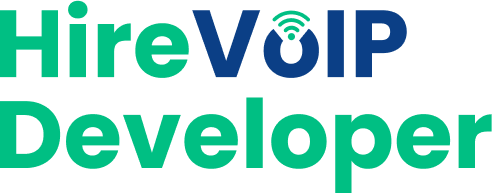Key Takeaways
- Identify and Fix Gaps: Address weak access controls, incomplete encryption, and integration vulnerabilities to ensure optimal security.
- Custom Development Matters: Tailored UCaaS security features enhance protection without slowing performance.
- Leverage AI & Adaptive Authentication: Proactively detect threats and dynamically secure access.
- Encrypt and Comply: End-to-end encryption and compliance-ready design safeguard data across regions.
- Monitor Continuously: Intelligent monitoring and automated alerts keep systems resilient and efficient.
Waiting for breaches to occur is no longer acceptable. UCaaS platforms must anticipate risks and proactively protect communications. Modern UCaaS platforms are the backbone of enterprise communication, integrating voice, video, messaging, and collaboration tools across multiple devices and cloud services. Yet, the complexity that enables seamless connectivity also creates significant security challenges, including weak access controls, integration vulnerabilities, and incomplete encryption.
Implementing secure UCaaS development ensures that security is architected into the system from the ground up, while UCaaS custom security solutions address platform-specific risks that off-the-shelf solutions cannot. Leveraging custom UCaaS security features, such as adaptive authentication, granular role-based access, and intelligent monitoring, allows organizations to maintain both resilience and performance.
Identifying these vulnerabilities is the crucial first step toward building a UCaaS platform that is secure, efficient, and compliance-ready. This process begins with identifying the most common security gaps across enterprise deployments. This blog explores the most critical UCaaS security gaps, the role of custom UCaaS security solutions, and the custom UCaaS security features that safeguard modern enterprises.
Did You Know?
The global unified communication (UC) market was valued at USD 146.73 billion in 2024 and is projected to grow to USD 525.90 billion by 2032, registering a CAGR of 17.3% over the forecast period.
What are the Most Common Security Gaps in UCaaS Platforms?
Even mature UCaaS platforms can exhibit structural weaknesses that compromise security. Recognizing these vulnerabilities is the essential first step toward designing and implementing effective defenses.
Since each UCaaS deployment varies in scale, regulatory requirements, and industry-specific risks, a one-size-fits-all approach is rarely sufficient. Leveraging UCaaS custom security solutions allows organizations to tailor protections according to the unique risk profile of their platform, ensuring that sensitive communication and collaboration remain safeguarded.
Common security gaps in UCaaS platforms include:
- Excessive Access Permissions
Many platforms ship with default user roles that provide broader access than necessary. This can inadvertently expose sensitive conversations, files, or administrative functions to unintended users. Implementing detailed, role-specific access controls ensures users only handle data pertinent to their duties.
- Incomplete Encryption
While most UCaaS platforms encrypt core communication channels, not all traffic, such as instant messaging, file transfers, or video streams, is protected end-to-end. This gap can leave sensitive data vulnerable to exposure during transmission. Implementing custom UCaaS security features, such as full-channel encryption, ensures that every communication element, including metadata, is secured against interception.
- Weak Authentication Protocols
Password-only systems remain common and are highly vulnerable to phishing, credential stuffing, and brute-force attacks. Integrating multi-layer authentication, adaptive verification, and device-based access controls strengthens user identity verification without reducing usability.
- Integration Vulnerabilities
Third-party applications, plugins, and API connections expand the functionality of UCaaS platforms but also increase the attack surface. If these integrations are not properly validated and monitored, they can serve as entry points for attackers. Custom security solutions can enforce strict access policies and continuous integration monitoring to minimize these risks.
- Insufficient Monitoring and Alerting
Without real-time threat detection and actionable alerts, security incidents may go unnoticed for extended periods, increasing the potential impact. Embedding intelligent monitoring, including anomaly detection and automated response mechanisms, enables rapid mitigation and improves overall resilience.
Addressing these gaps requires a combination of platform-specific controls, custom security features, and adaptive monitoring mechanisms.
🧩 Strengthen your UCaaS platform with tailored security solutions.
How Can AI Strengthen UCaaS Security Without Compromising Efficiency?
Artificial Intelligence is rapidly evolving into a core component of modern UCaaS security, enabling platforms to respond proactively to emerging threats without compromising performance. By continuously analyzing patterns in real-time, machine learning algorithms can detect anomalies, anticipate potential attacks, and automate responses, ensuring that communication systems remain both secure and highly available. Incorporating AI into secure UCaaS development enhances custom security solutions and strengthens UCaaS security features, making them adaptive, context-aware, and intelligent.

Key AI-driven strategies include:
- Behavioral Anomaly Detection
AI monitors user behavior across logins, access patterns, and communication activity. It flags deviations from established baselines, such as unusual login times, atypical file access, or unexpected message routing, allowing rapid investigation before these anomalies escalate into breaches.
- Adaptive Authentication Triggers
Rather than applying static multi-factor authentication (MFA) rules, AI dynamically adjusts verification requirements according to risk indicators, location, user behavior, and session context. This ensures high security without introducing friction for low-risk scenarios.
- Automated Threat Response
AI can contain or isolate potentially compromised accounts, block suspicious IP addresses, or quarantine risky files instantly. Automating responses reduces reliance on human intervention and shortens the window of exposure.
- Predictive Compliance Analytics
AI continuously analyzes communication patterns and system activity to detect potential policy or regulatory violations before they occur. This proactive approach supports compliance with frameworks such as HIPAA, GDPR, and other regional mandates, reducing the risk of fines or reputational damage.
- Integration Monitoring
AI evaluates third-party apps, plugins, and APIs for anomalous behavior, assessing whether new integrations introduce security risks. Continuous monitoring ensures that the platform maintains a secure ecosystem even as new services are added.
By leveraging AI in unified communication, organizations can achieve a dual benefit: enhanced protection and operational efficiency.
Can Custom Development Improve UCaaS Security Without Hurting Performance?
Custom development plays a pivotal role in strengthening UCaaS security while preserving, or even enhancing, system performance. Out-of-the-box UCaaS solutions often provide basic protections but may fall short in addressing organization-specific risks or maintaining high efficiency under complex usage patterns. By embedding security directly into the architecture through secure UCaaS development, organizations can implement targeted defenses that align with operational requirements without introducing bottlenecks. Similarly, UCaaS custom security solutions enable enterprises to tailor features to their unique workflows, protecting sensitive communications and regulatory data in a manner that standard configurations cannot.
Crucial approaches to performance-friendly custom security include:
- Granular Role-Based Access Controls
Instead of broad, default permissions, custom development enables precise control over who can access specific communication channels or administrative functions. Limiting access reduces the attack surface while preventing unnecessary friction for authorized users.
- Optimized Encryption Protocols
End-to-end encryption can be implemented selectively and efficiently, ensuring that all data, voice, video, messaging, and files are protected without slowing down communication pipelines. Custom algorithms and key management systems enable encryption to scale in tandem with platform usage.
- Adaptive Multi-Factor Authentication (MFA)
Rather than applying uniform MFA rules to all users, custom development allows authentication to dynamically adjust according to risk elements, including device type, user role, location, and behavioral patterns. This balances security with usability, minimizing unnecessary prompts for low-risk sessions.
- Secure API and Third-Party Integrations
Custom security ensures that external applications and plugins adhere to strict validation protocols, preventing them from becoming entry points for attackers while maintaining seamless interoperability.
- Efficient Monitoring and Automated Response
Custom-built monitoring systems can detect anomalies in real time, generate actionable alerts, and even trigger automated containment procedures without consuming excessive resources. This eases the workload for IT teams while maintaining high responsiveness.
Strategically applying these measures establishes a system that strikes a balance between security and efficiency. Once foundational performance is ensured, attention must turn to authentication methods, particularly multi-layered approaches that strengthen identity verification.
Did You Know?
By 2030, 75% of companies are expected to adopt unified communication platforms to drive digital transformation across their business operations.
What’s the Best Way to Add Multi-Layer Authentication in UCaaS Platforms?

Authentication serves as the first and most critical line of defense against unauthorized access in UCaaS environments. As platforms unify voice, video, messaging, and file-sharing capabilities, the risk of unauthorized intrusion grows. Multi-layer authentication ensures that only verified users can access sensitive communications, while maintaining seamless workflows for legitimate users. Leveraging custom UCaaS security features allows organizations to implement adaptive, layered authentication tailored to different user roles, device types, and operational contexts.
Effective multi-layer authentication strikes a balance between robust security and minimal user friction. It requires integrating multiple verification factors intelligently, dynamically adjusting to contextual risk, and aligning with broader security and compliance frameworks. This approach protects sensitive information while preserving the productivity benefits of unified communications.
Core approaches for implementing multi-layer authentication include:
- Role-Based Multi-Factor Authentication (MFA)
Users in high-risk roles, such as finance, human resources, or executive teams, require additional verification steps to reduce exposure to credential compromise. MFA can include combinations of passwords, OTPs, biometric verification, and hardware tokens, applied selectively based on the user’s risk profile.
- Device Recognition
Trusted devices can bypass additional verification steps, while unfamiliar or high-risk devices trigger enhanced authentication. This ensures security without slowing down routine workflows for known, low-risk endpoints.
- Contextual and Adaptive Authentication
Authentication requirements dynamically adjust based on factors such as geographic location, login time, and behavioral patterns. For instance, an access request from an unusual location may trigger additional verification, whereas a routine login from a trusted network proceeds smoothly.
- Single Sign-On (SSO) Integration
SSO enables users to access multiple UCaaS applications and integrated systems without repeated authentication prompts. When combined with adaptive MFA, SSO simplifies user experience while maintaining strong security across platforms.
- Session-Based Token Management
Session tokens refresh adaptively based on risk exposure, limiting the window for potential compromise. Tokens can expire more quickly for high-risk sessions and remain longer for verified, low-risk sessions, thereby maintaining both security and operational efficiency.
Layered authentication works most effectively when combined with robust encryption, AI-driven monitoring, and compliance mechanisms. Integrating these elements ensures that UCaaS platforms not only verify identities rigorously but also maintain the integrity, confidentiality, and availability of sensitive communications. By implementing adaptive, multi-layer authentication, organizations can secure their UCaaS environments while preserving seamless collaboration and user productivity.
What Role Does Custom Encryption and Authentication Play in UCaaS Security?

Encryption and authentication form the backbone of UCaaS security. While default or standard encryption may protect data in transit, it often does not extend to metadata, logs, or integrated third-party applications. Custom solutions allow organizations to enforce security policies across every layer of the UCaaS platform, ensuring that sensitive communications remain protected under all operational scenarios.
Custom encryption strategies secure data at multiple layers, making it resilient against sophisticated threats, including interception, man-in-the-middle attacks, and unauthorized access.
Advanced authentication mechanisms complement encryption by maintaining session integrity, ensuring that only verified users can access critical communication resources, and dynamically adjusting to contextual risk factors.
Critical custom encryption and authentication features include:
- End-to-end Encryption For All Channels
Every communication mode, voice, video, messaging, and file sharing, is individually encrypted. This prevents interception at any point in the transmission and ensures that sensitive data remains confidential even if network traffic is compromised.
- Custom Key Management
Organizations gain full control over key generation, rotation schedules, and revocation policies. This allows alignment with internal security standards, regulatory compliance requirements, and specific operational needs.
- Digital Signatures
These verify the authenticity of messages and communications, preventing spoofing and tampering. Digital signatures also provide audit trails that enhance accountability and traceability.
- Platform-Specific Authentication APIs
Custom APIs allow secure session management tailored to the organization’s workflows, enabling seamless authentication without negatively impacting system performance or user experience.
- Encrypted Metadata Storage
Sensitive contextual information, including call logs, message histories, and file metadata, is encrypted to prevent unauthorized access. This protects critical insights about communication patterns and organizational interactions.
Integrating strong encryption and advanced authentication not only safeguards communications but also supports compliance, regulatory reporting, and workflow efficiency. Platforms that implement these measures can deliver a secure communication environment while optimizing customer experience.
How to Build Compliance-Ready UCaaS Platforms for Different Regions (HIPAA, GDPR, etc.)?
Compliance is a critical pillar of UCaaS security, as organizations must protect sensitive communications while adhering to industry-specific and regional regulations. Non-compliance with these standards may trigger fines, reputational damage, and operational disruptions. Implementing UCaaS custom security solutions enables enterprises to design systems that are inherently compliant, thereby avoiding costly retrofits and ensuring consistent protection across all communication channels.
By embedding compliance directly into the platform architecture, organizations can manage multiple regulatory frameworks simultaneously without compromising functionality or user experience. Custom UCaaS security features enable businesses to dynamically enforce rules based on user role, geography, or data type, while maintaining seamless and uninterrupted communication workflows.
Key strategies for compliance-ready UCaaS platforms include:
- Region-Specific Encryption Standard
Implement encryption protocols that meet HIPAA, GDPR, or local privacy mandates, ensuring that sensitive data, whether in motion or at rest, is safeguarded at all times in accordance with jurisdictional requirements.
- Automated Audit Trails
Track user actions, system changes, and communication history automatically. This enables organizations to generate detailed compliance reports quickly, supports accountability, and simplifies regulatory audits.
- Data Residency Controls
Maintain sensitive information within designated geographic boundaries. Custom solutions ensure that data storage and processing locations align with regional requirements, minimizing legal and operational risk.
- Policy-Driven Access Management
Dynamically enforce compliance rules based on user attributes, role, or location. For example, certain functions may be restricted for users outside a defined region, preventing unauthorized access to regulated data.
- Compliance Dashboard
Provide real-time visibility into adherence and risk exposure for IT and security teams. Dashboards consolidate data across users, systems, and integrations, enabling proactive detection of potential compliance gaps before they escalate.
Integrating compliance into the core of UCaaS platforms strengthens both security and organizational trust. By combining these controls with custom development, AI-driven monitoring, and adaptive authentication, enterprises can maintain uninterrupted, secure communication while confidently meeting complex regulatory requirements.
Secure your APIs and integrations without affecting performance.
Conclusion
UCaaS security is a critical consideration for organizations that rely on unified communication systems. By addressing authentication, encryption, AI-driven monitoring, and compliance from the outset, enterprises can mitigate vulnerabilities while maintaining reliable and efficient communication. Designing platforms with scalability and adaptive security ensures that organizations are prepared for evolving threats without disrupting user experience. A thoughtful, layered approach to UCaaS security allows enterprises to maintain resilient, future-ready communication systems that support growth and long-term objectives.
Why settle for standard security when you can have custom-built protection? Hire VoIP Developers will help you transform your UCaaS platform into a seamless, secure, and high-performing communication powerhouse. Get in touch today!


